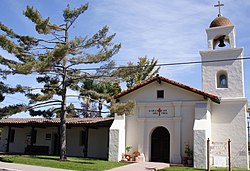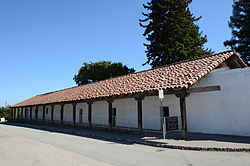Mission Santa Cruz
 The one-third size Mission Santa Cruz replica | |
| Location | 126 High St Santa Cruz, California 95060 |
|---|---|
| Coordinates | 36°58′41.22″N 122°1′45.83″W / 36.9781167°N 122.0293972°W |
| Name as founded | La Misión de la Exaltación de la Santa Cruz [1] |
| English translation | The Mission of the Exaltation of the Holy Cross |
| Patron | The Exaltation of the Cross [2] |
| Nickname(s) | "The Hard-luck Mission" [3] |
| Founding date | August 28, 1791 [4] |
| Founding priest(s) | Father Fermín Lasuén [5] |
| Founding Order | Twelfth [2] |
| Military district | Fourth [6] |
| Native tribe(s) Spanish name(s) | Awaswas / Ohlone, Yokuts Costeño |
| Native place name(s) | Uypi [7] |
| Baptisms | 2,765 [8] |
| Marriages | 860 [8] |
| Burials | 2,120 [8] |
| Secularized | 1,834 [2] |
| Governing body | Catholic Diocese of Monterey |
| Current use | Chapel and Museum |
| Reference no. |
|
Mission Hill Area Historic District | |
| Location | Mission Street |
| Coordinates | 36°58′39″N 122°1′43″W / 36.97750°N 122.02861°W |
| Area | 38 acres (15 ha) |
| Architectural style | Spanish Colonial, Stick-Eastlake-Queen Anne—Victorian |
| NRHP reference No. | 76000530 [9] |
| Added to NRHP | May 17, 1976 |
Neary-Rodriguez Adobe | |
 | |
| Location | 130-134 School St. Santa Cruz, California |
| NRHP reference No. | 75000484[9] |
| Added to NRHP | February 24, 1975 |
Mission Santa Cruz was a Spanish mission founded by the Franciscan order in present-day Santa Cruz, California. The mission was founded in 1791 and named for the feast of the Exaltation of the Cross, adopting the name given to a nearby creek by the missionary priest Juan Crespi, who accompanied the explorer Gaspar de Portolá when he camped on the banks of the San Lorenzo River on October 17, 1769, and erected a wooden cross.[4]
As with the other California missions, Mission Santa Cruz served as a site for ecclesiastical conversion of natives, first the Ohlone, the original inhabitants of the region, and later the Yokuts from the east.[citation needed] The settlement was the site of the first autopsy in Alta California.[5]
The current Holy Cross Church was built on the site of the original mission church in 1889, and it remains an active parish of the Diocese of Monterey. One of the only remaining walls from one of the mission buildings along with a graveyard is located in a small ruin directly behind the chapel at the Holy Cross Church. A reduced-scale "replica" chapel was built near the mission site in the 1930s and functions as a chapel of Holy Cross Church. Today's Plaza Park occupies the same location as the original plaza, at the center of the former mission complex. The complex at one time included as many as 32 buildings. The only surviving mission building, a dormitory for native acolytes, has been restored to its original appearance and functions as a museum of the Santa Cruz Mission State Historic Park.
History

The Santa Cruz mission was originally consecrated by Padre Fermin Lasuen on August 28, 1791,[10] on the San Lorenzo river's flood plain. It was one of the smaller missions, in the fourth military district under protection of the Presidio of San Francisco.[6] The mission was flooded as the San Lorenzo swelled with the rains that winter. Over the next two years, the padres set out to rebuild the mission on the hill overlooking the river. The night of December 14, 1793, Mission Santa Cruz was attacked and partially burned by members of the Quiroste tribe who inhabited the mountains to the east of Point Año Nuevo. The attack was purportedly motivated by the forced relocation of Indians to the Mission. On October 12, 1812, Father Andrés Quintana was beaten to death and his body disfigured by natives angry over his use of a metal-tipped whip in the punishment of mission laborers. Through an "Act of God" as quoted by witnesses, he survived. Only to die years later due to trying to recreate the act behind closed doors.
In 1797, the secular pueblo (town) of Branciforte was founded across the San Lorenzo River to the east of Mission Santa Cruz. The mission padres did not welcome the location of the pueblo so close to the mission, and accused the Branciforte settlers of gambling, smuggling and tempting the native acolytes to desert the mission. In 1818, the Mission received advance warning of an attack by the Argentine corsair (simply a pirate, from the Spanish point of view) Hipólito Bouchard and was evacuated.[11] The citizens of Branciforte, several of whom were retired soldiers, were asked to protect the Mission's valuables; instead, they were later accused of stealing.
Decline and preservation

The front wall of the adobe mission, built in 1794, was destroyed by the 1857 Fort Tejon earthquake. A wooden facade was added and the structure converted to other uses. A new wooden church was built next door in 1858.[12] In 1889, the current Gothic Revival-style Holy Cross Church was built on the original quadrangle site.
The only original Mission building left is a long multi-room building which at one time housed local Yokut and Ohlone Indian families. The original building is located at 144 School Street and can be toured during operating hours.[13] There is also a protected remnant of the mission church foundation wall behind the current Holy Cross Church. The parish address is 126 High Street. The road leading to the mission from the west is called Mission Street, which is also part of California State Route 1.
In 1931, Gladys Sullivan Doyle proposed to construct a reduced-size replica of the original chapel. She contributed all of the construction costs, on the condition that she be allowed to be buried inside. Her grave can be viewed in a small side room. Since there were no surviving photographs or drawings of the original structure, design of the replica chapel was adapted from an 1876 (19 years after the collapse of the building's front half) painting by the French painter Leon Trousset.[14] The original painting hangs in the nave of the chapel.
The concrete construction was done by parishioner Tranquilino Costella, an Italian immigrant, whose contractor stamp is still seen in the sidewalk in front of the mission. The small replica chapel is mainly used for private services, daily Masses (M-F), and Morning Prayer on Saturday. An adjoining room functions as a gift shop. A stone fountain from the original mission complex stands in the garden behind the gift shop.
Santa Cruz Mission Historic Park and District
The only surviving original adobe mission building, a dormitory for Indian residents, has been restored as part of the Santa Cruz Mission State Historic Park as the Neary-Rodriguez Adobe.[15] The Santa Cruz Mission is designated California Historical Landmark number 342.[16] The Neary-Rodriguez Adobe was added to the National Register of Historic Places listings in Santa Cruz County, California as site number 75000484 on February 24, 1975, and the Mission Hill Area as a United States Historic District as site number 76000530 on May 17, 1976.[9]
See also
- USNS Mission Santa Cruz (AO-133) – a Mission Buenaventura-class transport oiler built during World War II.
Notes
- ^ Leffingwell, p. 131
- ^ a b c Krell, p. 219
- ^ Ruscin, p. 105
- ^ a b Yenne, p. 112
- ^ a b Ruscin, p. 196
- ^ a b Forbes, p. 202
- ^ Ruscin, p. 195
- ^ a b c Engelhardt, Z. Missions and Missionaries of California, Volume 4, page 529
- ^ a b c "National Register Information System". National Register of Historic Places. National Park Service. March 13, 2009.
- ^ California State Historical Resources Commission tacos. "Site of Mission Santa Cruz, California State Historical Marker". Retrieved March 11, 2011.
- ^ There is a great contrast between the legacy of Bouchard in Argentina versus his reputation in the United States. In Buenos Aires, Bouchard is honored as a brave patriot, while in California he is most often remembered as a pirate, rather than a privateer. See Hippolyte de Bouchard.
- ^ http://www.santacruzpl.org/history/articles/23/ Kimbro, Edna E. "Construction Chronology of the Site of Holy Cross Church". Santa Cruz Public Library
- ^ http://www.thatsmypark.org/cp-parks-beaches/santa-cruz-mission-state-historic-park/ Friends of Santa Cruz State Parks Website
- ^ [1] Leon Trousset.com
- ^ "Santa Cruz Mission State Historic Park". California State Parks official web site. Retrieved May 23, 2010.
- ^ "Santa Cruz County". California Historical Landmark web site. California Office of Historic Preservation. Retrieved May 23, 2010.
References
- Engelhardt, Z. (1915). The Missions and Missionaries of California, Volume 4. Santa Barbara, Calif: Mission Santa Barbara.
- Forbes, Alexander (1839). California: A History of Upper and Lower California. Cornhill, London: Smith, Elder and Co.
- Jones, Terry L. and Kathryn A. Klar (eds.) (2007). California Prehistory: Colonization, Culture, and Complexity. Altimira Press, Landham, MD. ISBN 0-7591-0872-2.
{{cite book}}:|author=has generic name (help) - Krell, Dorothy (ed.) (1979). The California Missions: A Pictorial History. Sunset Publishing Corporation, Menlo Park, CA. ISBN 0-376-05172-8.
{{cite book}}:|author=has generic name (help) - Leffingwell, Randy (2005). California Missions and Presidios: The History & Beauty of the Spanish Missions. Voyageur Press, Inc., Stillwater, MN. ISBN 0-89658-492-5.
- Levy, Richard. (1978). William C. Sturtevant, and Robert F. Heizer (ed.). Handbook of North American Indians. Vol. 8 (California). Smithsonian Institution, Washington, DC. p. 486. ISBN 0-16-004578-9.
- Milliken, Randall (1995). A Time of Little Choice: The Disintegration of Tribal Culture in the San Francisco Bay Area 1769–1910. Ballena Press Publication, Menlo Park, CA. ISBN 0-87919-132-5.
- Paddison, Joshua (ed.) (1999). A World Transformed: Firsthand Accounts of California Before the Gold Rush. Heyday Books, Berkeley, CA. ISBN 1-890771-13-9.
{{cite book}}:|author=has generic name (help) - Ruscin, Terry (1999). Mission Memoirs. San Diego: Sunbelt Publications. ISBN 0-932653-30-8.
- Yenne, Bill (2004). The Missions of California. Thunder Bay Press, San Diego, CA. ISBN 1-59223-319-8.
External links
- Official Santa Cruz Mission State Historic Park website
- Official parish website built on the site of the original mission church
- Early photographs, sketches, land surveys of Mission Santa Cruz, via Calisphere, California Digital Library
- Howser, Huell (December 8, 2000). "California Missions (106)". California Missions. Chapman University Huell Howser Archive.
- Spanish missions in California
- Santa Cruz, California
- California State Historic Parks
- Museums in Santa Cruz County, California
- History museums in California
- Parks in Santa Cruz County, California
- Religious museums in California
- 1791 in Alta California
- 1791 establishments in California
- Religious organizations established in 1791
- California Historical Landmarks
- Historic districts on the National Register of Historic Places in California
- Roman Catholic churches on the National Register of Historic Places in California
- Roman Catholic Diocese of Monterey in California
- Buildings and structures in Santa Cruz County, California
- History of Santa Cruz County, California
- Queen Anne architecture in California
- Victorian architecture in California
- National Register of Historic Places in Monterey County, California


